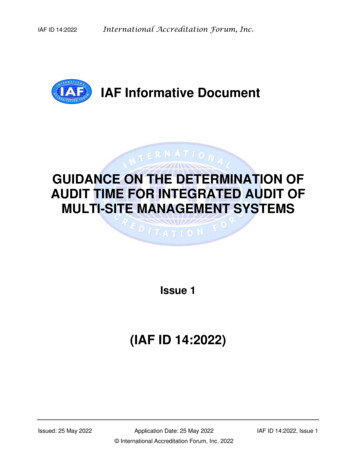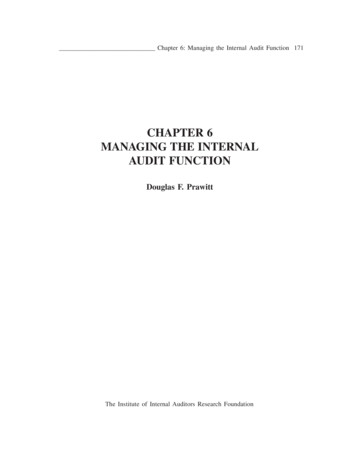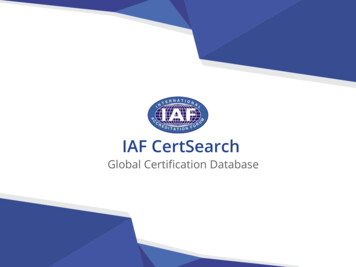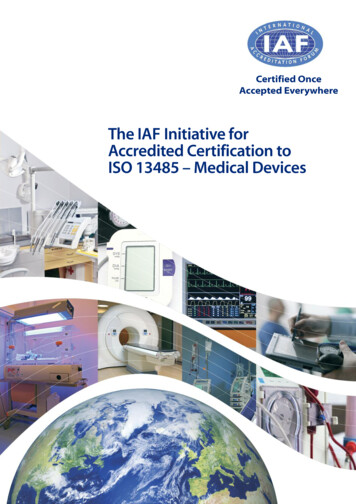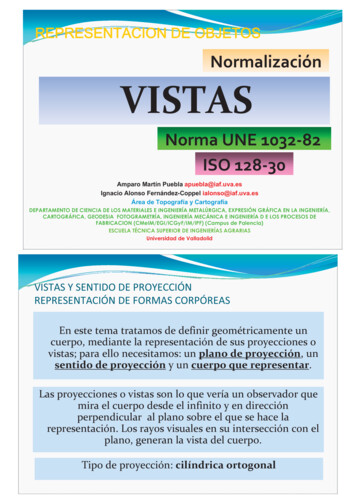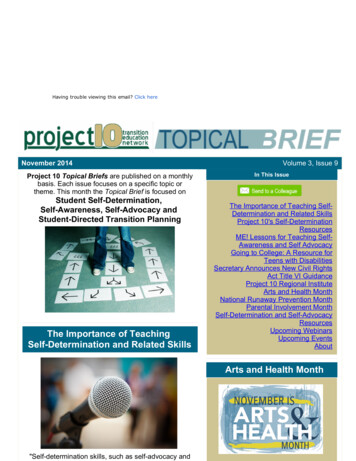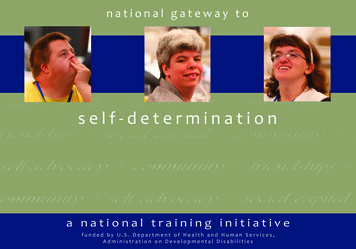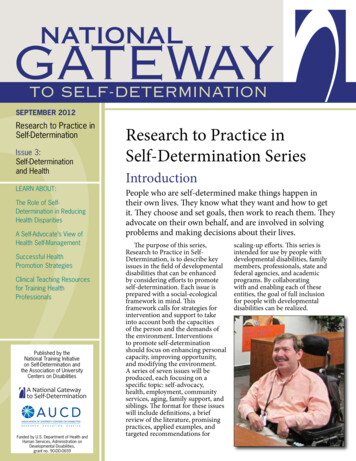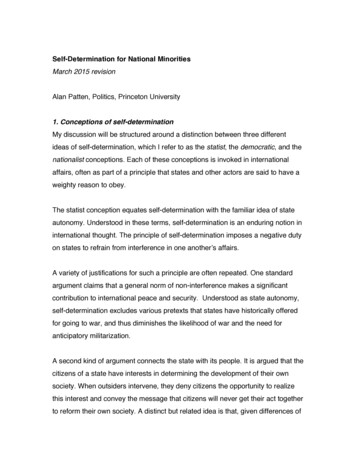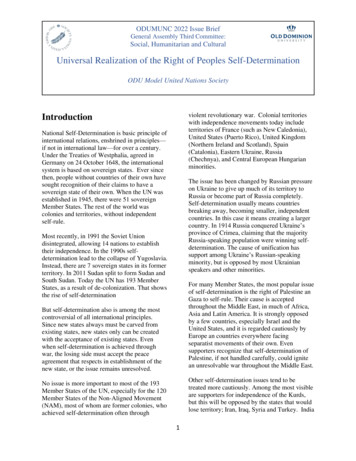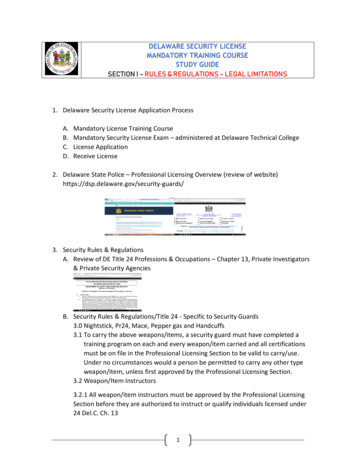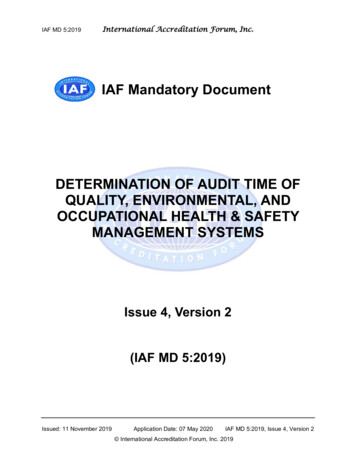
Transcription
IAF MD 5:2019International Accreditation Forum, Inc.IAF Mandatory DocumentDETERMINATION OF AUDIT TIME OFQUALITY, ENVIRONMENTAL, ANDOCCUPATIONAL HEALTH & SAFETYMANAGEMENT SYSTEMSIssue 4, Version 2(IAF MD 5:2019)Issued: 11 November 2019Application Date: 07 May 2020IAF MD 5:2019, Issue 4, Version 2 International Accreditation Forum, Inc. 2019
IAF MD 5:2019Issue 4Version 2International Accreditation Forum, Inc.Determination of Audit Time of Quality,Environmental, and Occupational Health & Safety Management SystemsPage 2 of 33The International Accreditation Forum, Inc. (IAF) facilitates trade and supportsregulators by operating a worldwide mutual recognition arrangement amongAccreditation Bodies (ABs) in order that the results issued by Conformity AssessmentBodies (CABs) accredited by IAF members are accepted globally.Accreditation reduces risk for business and its customers by assuring them thataccredited CABs are competent to carry out the work they undertake within their scopeof accreditation. ABs that are members of IAF and the CABs they accredit are requiredto comply with appropriate international standards and the applicable IAF applicationdocuments for the consistent application of those standards.ABs that are signatories to the IAF Multilateral Recognition Arrangement (MLA) areevaluated regularly by an appointed team of peers to provide confidence in theoperation of their accreditation programs. The structure and scope of the IAF MLA isdetailed in IAF PR 4 – Structure of IAF MLA and Endorsed Normative Documents.The IAF MLA is structured in five levels: Level 1 specifies mandatory criteria that applyto all ABs, ISO/IEC 17011. The combination of a Level 2 activity(ies) and thecorresponding Level 3 normative documents is called the main scope of the MLA, andthe combination of Level 4 (if applicable) and Level 5 relevant normative documents iscalled a sub-scope of the MLA. The main scope of the MLA includes activities e.g. product certification andassociated mandatory documents e.g. ISO/IEC 17065. The attestations madeby CABs at the main scope level are considered to be equally reliable. The sub scope of the MLA includes conformity assessment requirements e.g.ISO 9001 and scheme specific requirements, where applicable, e.g. ISO TS22003. The attestations made by CABs at the sub scope level are considered tobe equivalent.The IAF MLA delivers the confidence needed for market acceptance of conformityassessment outcomes. An attestation issued, within the scope of the IAF MLA, by abody that is accredited by an IAF MLA signatory AB can be recognized worldwide,thereby facilitating international trade.Issued: 11 November 2019Application Date: 07 May 2020IAF MD 5:2019 Issue 4, Version 2 International Accreditation Forum, Inc. 2019
IAF MD 5:2019Issue 4Version 2International Accreditation Forum, Inc.Determination of Audit Time of Quality,Environmental, and Occupational Health & Safety Management SystemsPage 3 of 33TABLE OF CONTENTS0. INTRODUCTION . 61. DEFINITIONS . 71.1.Management Systems Certification Scheme . 71.2.Client Organization . 71.3.Permanent Site. 71.4.Virtual Site . 71.5.Temporary Site . 71.6.Audit Time . 71.7.Duration of Management System Certification Audits . 71.8.Audit Day . 81.9.Effective Number of Personnel . 81.10. Risk Category (QMS only) . 81.11. Complexity Category (EMS only) . 81.12. Complexity Category (OH&SMS only) . 92. APPLICATION . 92.1.Audit Time . 92.2.Audit Day(s). 92.3.Calculation of the Effective Number of Personnel . 103. METHODOLOGY FOR DETERMINING AUDIT TIME OF MANAGEMENTSYSTEMS . 124. INITIAL MANAGEMENT SYSTEMS CERTIFICATION AUDITS (STAGE 1 PLUSSTAGE 2) . 145. SURVEILLANCE . 146. RECERTIFICATION. 157. INDIVIDUALIZED SECOND AND SUBSEQUENT CERTIFICATION CYCLES . 158. FACTORS FOR ADJUSTMENTS OF AUDIT TIME OF MANAGEMENTSYSTEMS (QMS, EMS, and OH&SMS) . 159. TEMPORARY SITES . 1810.AUDIT TIME OF A MULTI-SITE MANAGEMENT SYSTEM. 1811.CONTROL OF EXTERNALLY PROVIDED FUNCTIONS OR PROCESSES(OUTSOURCING) . 19Issued: 11 November 2019Application Date: 07 May 2020IAF MD 5:2019 Issue 4, Version 2 International Accreditation Forum, Inc. 2019
IAF MD 5:2019Issue 4Version 2International Accreditation Forum, Inc.Determination of Audit Time of Quality,Environmental, and Occupational Health & Safety Management SystemsPage 4 of 33ANNEX A – QUALITY MANAGEMENT SYSTEMS . 21ANNEX B – ENVIRONMENTAL MANAGEMENT SYSTEMS . 24ANNEX C – OCCUPATIONAL HEALTH AND SAFETY MANAGEMENT SYSTEMS . 29Issue No 4, Version 2Prepared by: IAF Technical CommitteeApproved by: IAF MembersIssue Date: 11 November 2019Name for Enquiries: Elva NilsenIAF Corporate SecretaryTelephone: 1 613 454-8159Email: secretary@iaf.nuIssued: 11 November 2019Date: 17 December 2018Application Date: 07 May 2020Application Date: 07 May 2020IAF MD 5:2019 Issue 4, Version 2 International Accreditation Forum, Inc. 2019
IAF MD 5:2019Issue 4Version 2International Accreditation Forum, Inc.Determination of Audit Time of Quality,Environmental, and Occupational Health & Safety Management SystemsPage 5 of 33INTRODUCTION TO IAF MANDATORY DOCUMENTSThe term “should” is used in this document to indicate recognised means of meeting therequirements of the standard. A Conformity Assessment Body (CAB) can meet these inan equivalent way provided this can be demonstrated to an Accreditation Body (AB).The term “shall” is used in this document to indicate those provisions which, reflectingthe requirements of the relevant standard, are mandatory.Issued: 11 November 2019Application Date: 07 May 2020IAF MD 5:2019 Issue 4, Version 2 International Accreditation Forum, Inc. 2019
IAF MD 5:2019Issue 4Version 2International Accreditation Forum, Inc.Determination of Audit Time of Quality,Environmental, and Occupational Health & Safety Management SystemsPage 6 of 33DETERMINATION OF AUDIT TIME OF QUALITY,ENVIRONMENTAL, AND OCCUPATIONAL HEALTH &SAFETY MANAGEMENT SYSTEMSThis document is mandatory for the consistent application of the relevant clauses ofISO/IEC 17021-1 for audits of quality, environmental and occupational health and safetymanagement systems. All clauses of ISO/IEC 17021-1 continue to apply and thisdocument does not supersede any of the requirements in that standard. Althoughpersonnel numbers (permanent, temporary, and part time) of the client are used as thestarting point when considering the determination of audit time of management systems,this is not the sole consideration and account shall be taken of other factors affectingthe audit time, including all those listed in ISO/IEC 17021-1.0.INTRODUCTION0.1. The correct determination of the audit time for an initial audit (Stage 1 plus Stage2) is an integral part of the application review for any client organization.0.2. This document provides mandatory provisions and guidance for CABs to developtheir own processes for determining the amount of time required for the auditing ofclients of differing sizes and complexity over a broad spectrum of activities. It isintended that this will lead to consistency of the determination of audit time ofmanagement systems between CABs, as well as between similar clients of the sameCAB.0.3. CABs shall identify the audit time of the Stage 1 and Stage 2 initial audit and ofsurveillance and re-certification audits for each applicant and certified client.0.4. This mandatory document provides a framework that shall be utilized within aCAB’s processes to determine appropriate audit time of management systems, takinginto account the specifics of the client to be audited.0.5. Although this document is set up for EMS/QMS/OH&SMS certification, a numberof elements may be used for other ISO/IEC 17021-1 based certification schemes.Examples of these elements are the application of audit time duration or audit day andeffective personnel.0.6. Notwithstanding the guidance provided by this document, the time allocated for aspecific audit should be sufficient to plan and accomplish a complete and effective auditof the client's management system.Issued: 11 November 2019Application Date: 07 May 2020IAF MD 5:2019 Issue 4, Version 2 International Accreditation Forum, Inc. 2019
IAF MD 5:2019Issue 4Version 21.International Accreditation Forum, Inc.Determination of Audit Time of Quality,Environmental, and Occupational Health & Safety Management SystemsPage 7 of 33DEFINITIONSFor the purposes of this document, the following definitions apply:1.1.Management Systems Certification SchemeConformity assessment system related to management systems to which the samespecified requirements, specific rules and processes apply.1.2.Client OrganizationEntity or defined part of an entity operating a management system.1.3.Permanent SiteLocation (physical or virtual) where a client organization (1.2) performs work or providesa service on a continuing basis.1.4.Virtual SiteVirtual location where a client organization performs work or provides a service using anon-line environment allowing persons irrespective of physical locations to executeprocesses.Note 1: A virtual site cannot be considered where the processes must be executed in aphysical environment, e.g., warehousing, manufacturing, physical testinglaboratories, installation or repairs to physical products.Note 2: A virtual site (e.g. company intranet) is considered a single site for the calculation ofaudit time.1.5.Temporary SiteLocation (physical or virtual) where a client organization (1.2) performs specific work orprovides a service for a finite period of time and which is not intended to become apermanent site (1.3).1.6.Audit TimeTime needed to plan and accomplish a complete and effective audit of the clientorganization’s management system (ISO/IEC 17021-1).1.7.Duration of Management System Certification AuditsPart of audit time (1.6) spent conducting audit activities from the opening meeting to theclosing meeting, inclusive.Issued: 11 November 2019Application Date: 07 May 2020IAF MD 5:2019 Issue 4, Version 2 International Accreditation Forum, Inc. 2019
IAF MD 5:2019Issue 4Version 2Note:1.8.International Accreditation Forum, Inc.Determination of Audit Time of Quality,Environmental, and Occupational Health & Safety Management SystemsPage 8 of 33Audit activities normally include: conducting the opening meeting performing document review while conducting the audit communicating during the audit assigning roles and responsibilities of guides and observers collecting and verifying information generating audit findings preparing audit conclusions conducting the closing meetingAudit DayThe duration of an audit day is normally 8 hours and may or may not include a lunchbreak depending upon local legislation.1.9.Effective Number of PersonnelThe effective number of personnel consists of all personnel (permanent, temporary, andpart-time) involved within the scope of certification including those working on eachshift. When included within the scope of certification, it shall also include non-permanent(e.g. contractors) personnel.For OH&SMS it shall also include personnel from contractors and subcontractorsperforming work or work-related activities that are under the control or influence of theorganization, that can have impact on the organization’s OH&SMS performance.Refer to 2.3 for calculation of effective number of personnel.1.10. Risk Category (QMS only)For QMS, the provisions in this document are based on three categories, dependant onthe risks posed by failure of the product or service of the client organization. Thesecategories can be considered as high, medium or low risk. High risk activities (e.g.nuclear, medical, pharmaceutical, food, construction) normally require more audit time.Medium risk activities (e.g., simple manufacturing) are likely to require the average timeto carry out an effective audit and low risk activities less time. (See Annex A, Table QMS2).1.11. Complexity Category (EMS only)For environmental management systems, the provisions specified in this document arebased on five primary complexity categories of the nature, number and gravity of theenvironmental aspects of an organization that fundamentally affect the audit time. (SeeAnnex B, Table EMS 2).Issued: 11 November 2019Application Date: 07 May 2020IAF MD 5:2019 Issue 4, Version 2 International Accreditation Forum, Inc. 2019
IAF MD 5:2019Issue 4Version 2International Accreditation Forum, Inc.Determination of Audit Time of Quality,Environmental, and Occupational Health & Safety Management SystemsPage 9 of 331.12. Complexity Category (OH&SMS only)For OH&SMS, the provisions specified in this document are based on three primarycomplexity categories based on the nature, number and severity of the OH&S risks ofan organization that fundamentally affect the audit time (See Annex C, Table OH&SMS2).2.APPLICATION2.1.Audit Time2.1.1. The audit time for all types of audits includes the total time on-site at a client'slocation (physical or virtual) (1.7) and time spent off-site carrying out planning,document review, interacting with client personnel and report writing.2.1.2. The duration of a management system certification audit (1.7) should typically notbe less than 80% of the audit time calculated following the methodology in Section 3.This applies to initial, surveillance and recertification audits.2.1.3. Travel (en-route or between sites) and any breaks are not included in the on-siteduration of management system certification audits.Note: See 1.8. There may be a local legal requirement to include lunch breaks.2.2.Audit Day(s)2.2.1. Tables QMS 1, EMS 1, and OH&SMS 1 present the average audit time ofmanagement systems certification audits calculated in audit days. National adjustmentson the number of days may be needed to comply with local legislation for travel, lunchbreaks and working hours, to achieve the same total number of days of auditing fromTables QMS 1, EMS 1, and OH&SMS 1.2.2.2. The number of audit days allocated shall not be reduced at the planning stagesby programming longer hours per working day. Consideration can be made to allowefficient auditing of shift activities which may require additional hours in a working day.2.2.3. If after the calculation, the result is a decimal number, the number of days shouldbe adjusted to the nearest half day (e.g.: 5.3 audit days becomes 5.5 audit days, 5.2audit days becomes 5 audit days).2.2.4. To help ensure the effectiveness of the audit, the CAB should also consider thecomposition and size of the audit team (e.g. ½ day with 2 auditors may not be aseffective as a one day audit with 1 auditor or 1 audit day with one lead auditor and onetechnical expert is more effective than 1 auditor day without the technical expert).Issued: 11 November 2019Application Date: 07 May 2020IAF MD 5:2019 Issue 4, Version 2 International Accreditation Forum, Inc. 2019
IAF MD 5:2019Issue 4Version 2International Accreditation Forum, Inc.Determination of Audit Time of Quality,Page 10 of 33Environmental, and Occupational Health & Safety Management SystemsNote 1: ABs may require a CAB to demonstrate that the average audit time of specified clientsis neither significantly more nor less than the audit time calculated from tables QMS1, EMS1,and OH&SMS1.Note 2: CABs that work primarily in high risk or complex industries are likely to have an averagehigher than the tables and CABs that work primarily in low risk industries are likely to have anaverage lower than the tables.2.3.Calculation of the Effective Number of Personnel2.3.1. The effective number of personnel as defined above is used as a basis for thecalculation of audit time of management systems. Considerations for determining theeffective number of employees include part-time personnel and employees partially inscope, those working on shifts, administrative and all categories of office staff, similar orrepetitive processes (see 2.3.4) and the employment of large numbers of unskilledpersonnel in some countries.In case of seasonal operations (e.g. harvesting activities, holiday villages and hotels,etc.) the calculation of the effective number of personnel shall be based on thepersonnel typically present in peak season operations.Reductions due to employment of large numbers of unskilled personnel shall not bemade without consideration of the associated OH&S risk (see 2.3.6).2.3.2. The justification to determine the effective number of personnel shall be availableto the client organization and to the Accreditation Body for review during theirassessments and on request from the Accreditation Body.2.3.3. Part time personnel and employees partially in scopeDependent upon the hours worked, part time personnel numbers and employeespartially in scope may be reduced or increased and converted to an equivalent numberof full time personnel. (e.g. 30 part time personnel working 4 hours/day equates to 15full time personnel.)2.3.4. Similar or repetitive process within scopeFor QMS and EMS, when a high percentage of personnel perform certainactivities/positions that are considered repetitive (e.g. cleaners, security, transport, sales,call centers, etc.) a reduction to the number of personnel which is coherent andconsistently applied on a company to company basis within the scope of certification ispermitted. The methods incorporated for the reduction shall be documented to includeany consideration of the risk of the activities/positions.Issued: 11 November 2019Application Date: 07 May 2020IAF MD 5:2019 Issue 4, Version 2 International Accreditation Forum, Inc. 2019
IAF MD 5:2019Issue 4Version 2International Accreditation Forum, Inc.Determination of Audit Time of Quality,Page 11 of 33Environmental, and Occupational Health & Safety Management SystemsFor OH&SMS:a) When a high percentage of personnel perform certain activities/positions thatare considered similar or identical because they expose personnel to similarOH&S risks (e.g. cleaners, security, sales, call centers, etc.) a reduction inthe number of personnel which is coherent and consistently applied on acompany to company basis within the scope of certification is permitted. Themethods incorporated for the reduction shall be documented to include anyconsideration of the risk of the activities/positions.b) For groups of workers performing repetitive jobs which can reduce attention,and raise the associated level of OH&S risk (e.g. mounting, assembling,packaging, sorting, etc.), the methods incorporated for possible reductionsshall be documented to include the assessment of the OH&S risk of anyactivities/positions of workers.2.3.5. Shift work employeesThe CAB shall determine the duration and timing of the audit which will best assess theeffective implementation of the management system for the full scope of the clientactivities, including the need to audit outside normal working hours and various shiftpatterns. This shall be agreed with the client.The CAB should ensure that any variation in audit time does not compromise theeffectiveness of audits (see also clause 3.7).2.3.6. Temporary unskilled personnelThis issue normally only applies for organizations with a low level of technology wheretemporary unskilled personnel may be employed in considerable numbers to replaceautomated processes.For QMS and EMS, under these circumstances, a reduction in effective personnel maybe made. Being the consideration of processes more important than employee number,this reduction is unusual and the justification for doing so shall be recorded and madeavailable to the AB.For OH&SMS this reduction is in principle to be regarded as not applicable since theemployment of temporary unskilled personnel can be a source of OH&S risks. If, inexceptional cases, a reduction is made, the justification for doing so shall be recordedand made available to the AB.Issued: 11 November 2019Application Date: 07 May 2020IAF MD 5:2019 Issue 4, Version 2 International Accreditation Forum, Inc. 2019
IAF MD 5:2019Issue 4Version 2International Accreditation Forum, Inc.Determination of Audit Time of Quality,Page 12 of 33Environmental, and Occupational Health & Safety Management Systems3.METHODOLOGY FOR DETERMINING AUDIT TIME OF MANAGEMENTSYSTEMS3.1. The methodology used as a basis for the calculation of audit time of managementsystems for an initial audit (Stage 1 Stage 2) involves the understanding of tables andfigures in Annex A for QMS, Annex B for EMS, and Annex C for OH&SMS auditsrespectively. Annex A (QMS) is based upon the effective number of personnel (seeClause 2.3 for guidance on the calculation of the effective number of personnel) and thelevel of risk, but does not provide minimum or maximum audit time. In addition toeffective number of personnel, Annex B (EMS) is based also on the environmentalcomplexity of the organization and does not provide minimum or maximum audit time,Annex C (OH&SMS) is based upon the effective number of personnel and thecomplexity category of OH&S risk associated with the business sector of theorganization and does not provide a minimum or maximum audit time. Table OH&SMS 2shows the linkage between business sectors and OH&S complexity categories basedon OH&S risks.Note: Normal practice is that time spent for Stage 2 exceeds time spent for Stage 1.3.2. Using a suitable multiplier, the same tables and figures may be used as the basefor calculating audit time for surveillance audits (Clause 5) and recertification audits(Clause 6).3.3. The CAB shall have processes that provide for the allocation of adequate time forauditing of relevant processes of the client. Experience has shown that apart from thenumber of personnel, the time required to carry out an effective audit depends uponother factors for QMS, EMS, and OH&SMS. These factors are explored in more depth inClause 8.3.4. This mandatory document lists the provisions which should be considered whenestablishing the amount of time needed to perform an audit. These and other factorsneed to be examined during the CAB’s application review process and after Stage 1and throughout the certification cycle and at recertification for their potential impact onthe determination of audit time regardless of the type of audit. Therefore, the relevanttables, figures, and diagrams for QMS, EMS, and OH&SMS which demonstrate therelationship between effective number of personnel and complexity, cannot be used inisolation. These tables and figures provide the framework for audit planning andtherefore required adjustments for the determination of audit time for all types of audits.3.5. For QMS audits, Figure QMS 1 provides a visual guide to making adjustmentsfrom the audit time calculated from Table QMS 1 and provides the framework for aprocess that should be used for audit planning by identifying a starting point based onthe total effective number of personnel for all shifts.Issued: 11 November 2019Application Date: 07 May 2020IAF MD 5:2019 Issue 4, Version 2 International Accreditation Forum, Inc. 2019
IAF MD 5:2019Issue 4Version 2International Accreditation Forum, Inc.Determination of Audit Time of Quality,Page 13 of 33Environmental, and Occupational Health & Safety Management Systems3.6. For an EMS audit, it is appropriate to base audit time on the effective number ofpersonnel of the organization and the nature, number and gravity of the environmentalaspects of the typical organization in that industry sector. Tables EMS 1 and EMS 2provide the framework for the process that should be used for audit planning. The audittime of management systems should then be adjusted based on any significant factorsthat uniquely apply to the organization to be audited.For an OH&SMS audit, it is appropriate to base audit time on the effective number ofpersonnel of the organization and nature, number and severity of the OH&S risks of thetypical organization in that industry sector. Tables OH&SMS 1 and OH&SMS 2 provide aframework for the process that should be used for planning. The audit time ofmanagement systems should then be adjusted based on any significant factors thatuniquely apply to the organization to be audited.3.7. The starting point for determining audit time of management systems shall beidentified based on the effective number of personnel, then adjusted for the significantfactors applying to the client to be audited, and attributing to each factor an additive orsubtractive weighting to modify the base figure. In every situation, the basis for theestablishment of audit time of management systems including adjustments made shallbe recorded. The CAB should ensure that any variation in audit time does not lead to acompromise on the effectiveness of audits.For QMS and EMS, where product or service realization processes operate on a shiftbasis, the extent of auditing of each shift by the CAB depends on the processes doneon each shift, and the level of control of each shift that is demonstrated by the client. Toaudit effective implementation, at least one of the shifts shall be audited. Thejustification for not auditing the other shifts (e.g. those outside of regular office hours)shall be documented.For OH&SMS, where product or service realization processes operate on a shift basis,the extent of auditing of each shift by the CAB depends on the processes done on eachshift, taking into consideration the associated OH&S risks, and the level of control ofeach shift that is demonstrated by the client. To audit effective implementation, at leastone of the shifts inside and one outside of regular office hours shall be audited duringthe first cycle of certification. During surveillance audits of the subsequent cycles, theCB may decide not to audit the second shift based on the recognised maturity of theorganization’s OH&SMS. Adjustments for delaying the starting time of audit arerecommended whenever possible, in order to cover both shifts within the audit day. Thejustification for not auditing the other shifts shall be documented taking into account therisk for not doing so.3.8. The audit time of management systems determined using the tables or figures inAnnexes A, B, and C shall not include the time of “auditors-in-training”, observers or thetime of technical experts.Issued: 11 November 2019Application Date: 07 May 2020IAF MD 5:2019 Issue 4, Version 2 International Accreditation Forum, Inc. 2019
IAF MD 5:2019Issue 4Version 2International Accreditation Forum, Inc.Determination of Audit Time of Quality,Page 14 of 33Environmental, and Occupational Health & Safety Management Systems3.9. The reduction of audit time of management systems shall not exceed 30% of thetimes established from Tables QMS 1, EMS 1, or OH&SMS 1.Note: Clause 3.9 may not apply to the situations as described in IAF MD1 for the individual sitesin multi-site operations. In this situation, a limited number of processes may be present in suchsites and the implementation of all relevant requirements of the management systemstandards(s) can be verified.4.INITIAL MANAGEMENT SYSTEMS CERTIFICATION AUDITS (STAGE 1 PLUSSTAGE 2)4.1. Determination of audit time of management systems involved in combined offsiteactivities (Clause 2.1) should not reduce the total on-site duration of managementsystems audits to less than 80% of the audit time calculated from the tables followingthe methodology in Section 3. Where additional audit time is required for planningand/or report writing, this will not be justification for reducing the on-site duration ofmanagement systems certification audits.4.2. Table QMS 1, Table EMS 1, and Table OH&SMS 1 provide a starting point forestimating the audit time of an initial audit (Stage 1 Stage 2) for QMS, EMS, andOH&SMS respectively.4.3. The aud
SAFETY MANAGEMENT SYSTEMS This document is mandatory for the consistent application of the relevant clauses of ISO/IEC 17021-1 for audits of quality, environmental and occupational health and safety management systems. All clauses of ISO/IEC 17021-1 continue to apply and this document does not supersede any of the requirements in that standard.
